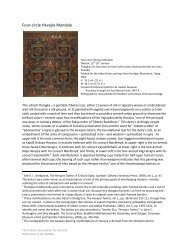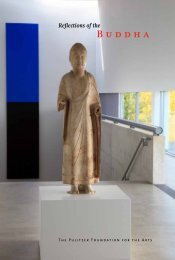Womb World Mandala (TaizÅkai mandara) - Reflections of the Buddha
Womb World Mandala (TaizÅkai mandara) - Reflections of the Buddha
Womb World Mandala (TaizÅkai mandara) - Reflections of the Buddha
You also want an ePaper? Increase the reach of your titles
YUMPU automatically turns print PDFs into web optimized ePapers that Google loves.
<strong>Womb</strong> <strong>World</strong> <strong>Mandala</strong> (Taizōkai <strong>Mandala</strong>) 2<br />
came into contact with native elements, whilst simultaneously being brought into dialogue with older<br />
designs and doctrines from <strong>the</strong> continent. This is an example <strong>of</strong> a <strong>Womb</strong> <strong>World</strong> <strong>Mandala</strong> (Japanese,<br />
Taizōkai mandala 胎 蔵 界 ), originally one half <strong>of</strong> a pair, which illustrates active instantiations <strong>of</strong> <strong>the</strong><br />
absolute truth <strong>of</strong> Buddhism in <strong>the</strong> phenomenal world. This absolute truth is represented by <strong>the</strong><br />
meditative figure in <strong>the</strong> center, <strong>the</strong> <strong>Buddha</strong> Mahavairocana (Japanese Dainichi nyorai 大 日 如 来 ), while<br />
<strong>the</strong> surrounding figures represent various aspects <strong>of</strong> that truth, all <strong>of</strong> which are manifestations <strong>of</strong><br />
Mahavairocana.<br />
Originally constructed in three-dimensional form for <strong>the</strong> physical demarcation <strong>of</strong> space for a rite, ritual<br />
contemplation or specific initiation ceremonies, 3 two-dimensional mandala such as this one maintain<br />
<strong>the</strong> connection with physical space by serving as ground plans for three-dimensional architectural<br />
structures - palaces - that can be constructed within <strong>the</strong> imagination. 4 Mahavairocana is placed in a lotus<br />
flower in <strong>the</strong> central and uppermost level <strong>of</strong> a multi-tiered palace, and moving outwards and<br />
downwards from his divine and unchanging presence we find an ordered hierarchical arrangement <strong>of</strong><br />
<strong>Buddha</strong>s and bodhisattvas before passing into more chaotic realms <strong>of</strong> progressively less enlightened<br />
beings, until we reach, in <strong>the</strong> outer edges <strong>of</strong> <strong>the</strong> mandala, <strong>the</strong> occupants <strong>of</strong> <strong>the</strong> lower realms <strong>of</strong><br />
existence in <strong>the</strong> outer edges <strong>of</strong> <strong>the</strong> mandala, such as humans, animals, and hungry ghosts.<br />
Once initiated into <strong>the</strong> proper use <strong>of</strong> <strong>the</strong>se mandala a practitioner is able to use it as a guide to an<br />
internal pilgrimage. Entering through <strong>the</strong> outer gates that indicate <strong>the</strong> transition from pr<strong>of</strong>ane to divine<br />
space, <strong>the</strong> initiate can mark milestones <strong>of</strong> spiritual progress by passing through its compartmentalized<br />
3 Contemporary Tibetan Buddhists continue <strong>the</strong> ancient practice <strong>of</strong> constructing mandala out <strong>of</strong> colored sand for<br />
<strong>the</strong> purposes <strong>of</strong> a specific rite, and destroying <strong>the</strong>m after it has been completed, though both <strong>the</strong> ritual use and<br />
<strong>the</strong> preparation <strong>of</strong> <strong>the</strong> mandala are acts <strong>of</strong> worship. See M. Brauen, The <strong>Mandala</strong>, Sacred Circle in Tibetan<br />
Buddhism. London: Serindia Press (1997).<br />
4 The visual dependence on a coherent architectural structure in <strong>the</strong> <strong>Womb</strong> <strong>World</strong> mandala is indicative <strong>of</strong> <strong>the</strong><br />
time in which it was produced. Though <strong>the</strong> seventh-century text on which <strong>the</strong> mandala is based, <strong>the</strong><br />
Mahavairocana Sutra 大 日 経 (Japanese, Dainichi-kyō), does give particular details, <strong>the</strong> displayed architecture <strong>of</strong><br />
gabled ro<strong>of</strong>s and gateways are reminiscent <strong>of</strong> Tang period 唐 朝 (618 - 907) Chinese palace architecture <strong>of</strong> <strong>the</strong><br />
eighth century, when <strong>the</strong> iconography for <strong>the</strong> <strong>Womb</strong> <strong>World</strong> mandala was established (ten Grotenhuis 1999, p. 6).<br />
Ideas for <strong>the</strong> composition <strong>of</strong> <strong>the</strong> mandala are drawn from chapter two <strong>of</strong> <strong>the</strong> Mahavairocana Sutra, which<br />
had been translated into Chinese by Subhakarasimha 善 無 畏 (637-735) and I-hsing 張 遂 (683-727). Kūkai<br />
introduced <strong>the</strong> sutra and its commentary in a version referred to as <strong>the</strong> Dainichi-kyō-sho and Ennin 圓 仁 or 円 仁<br />
(793 - 864) introduced ano<strong>the</strong>r version referred to as <strong>the</strong> Dainichi-kyō Gishaku. Shingon employs <strong>the</strong> former sutra,<br />
and <strong>the</strong> Tendai 天 台 sect <strong>the</strong> latter.<br />
The Pulitzer Foundation for <strong>the</strong> Arts<br />
<strong>Reflections</strong> <strong>of</strong> <strong>the</strong> <strong>Buddha</strong>




